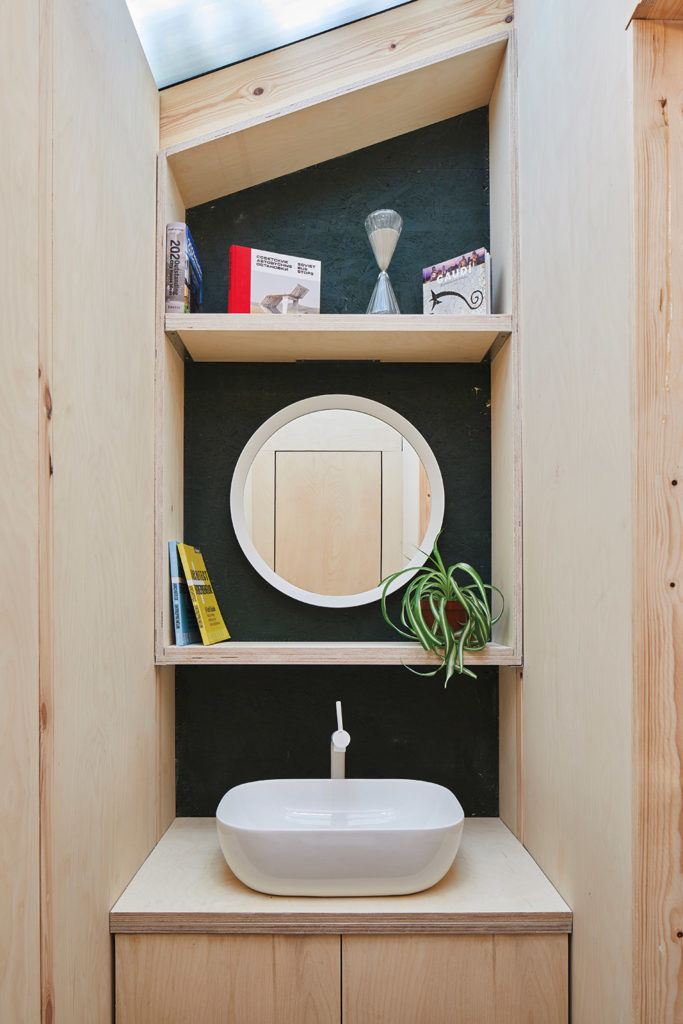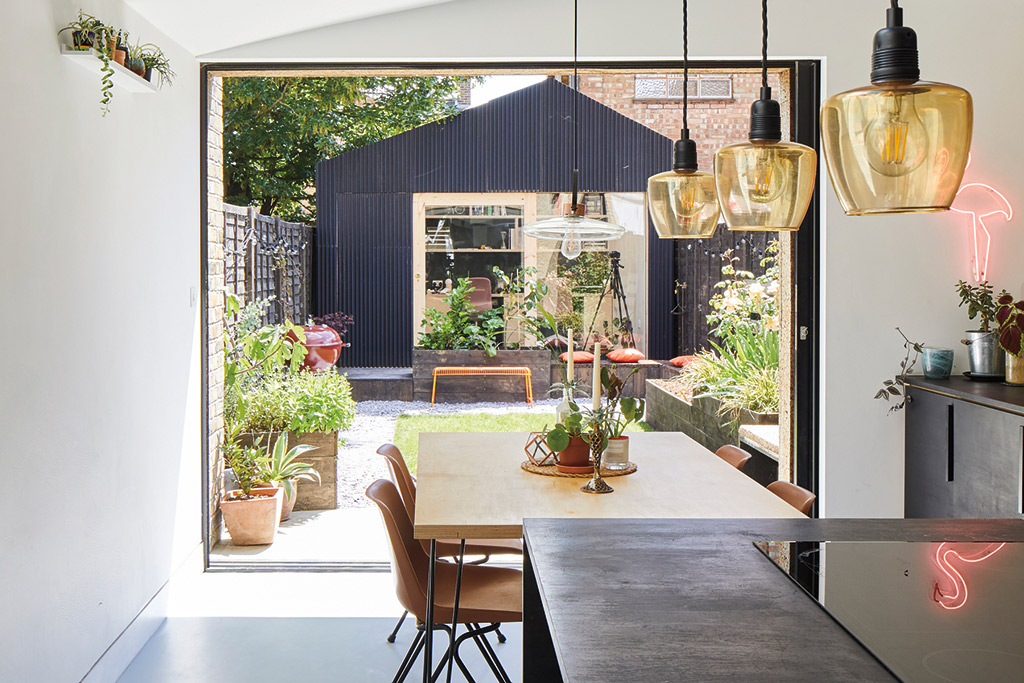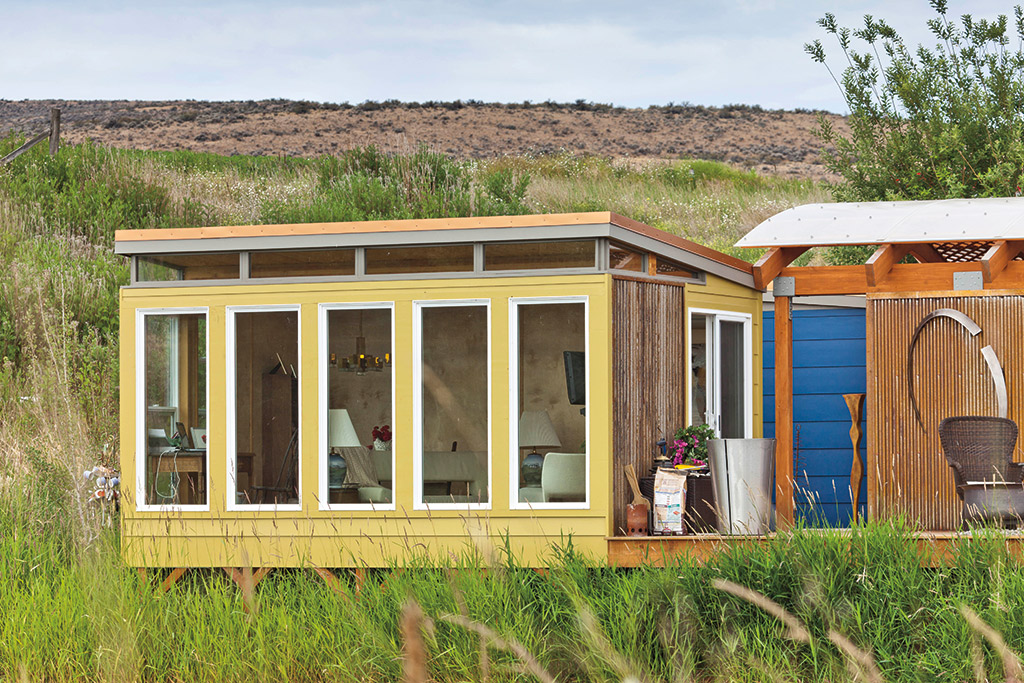When architect Richard John Andrews and his partner left their London flat for a house in Forest Gate, their motivations were cost and space. They could afford a house for the price of their Hackney flat and free up some money for design projects. Andrews was starting his practice and needed an office, but didn’t want the overhead cost of renting. As a result of these functional needs, combined with his drive to create, Andrews crafted the Light Shed.
It’s just one example of how the common garden shed is being reinvented for the work-from-home age. Well-crafted, small, and sculptural structures are increasingly dotting back gardens from Brooklyn to Melbourne, as design appreciation and desire for increased space converge among homeowners.

The Light Shed by Richard John Andrews: photographed by Chris Snook.
“You have these perfect locations at the bottom of gardens, which are very rarely used for anything specific,” said Andrews, “and which you can really explore and capitalize on—especially as a homeowner—to essentially create a whole new room.” The 12-square-metre Light Shed is clad with corrugated black fibreglass, and takes its name from a translucent polycarbonate roof. Andrews’s architectural garden studio has many admirers. And the idea of a hybrid or reinvented shed has taken hold over the past decade as people began to reconceptualize their relationship with their living spaces.
These modern sheds are outbuildings but, unless specifically meant for garden storage, their similarity to traditional sheds ends with their dimensions. Potential uses for these buildings are almost as varied as their architectural styles. People are building music rooms, art studios, yoga retreats, extra bedrooms, and even, in some cases, bars in their backyards. And while the trend has existed for years in London—where terrace houses often have gardens—it’s only more recently reached North American homeowners.

The Light Shed by Richard John Andrews: photographed by Chris Snook.
“People are very interested in interior design, and architecture and design, and they like to do things at home,” says Helsinki-based Avanto Architects co-founder Ville Hara. “And home is no longer just a place where you sleep, but also where you express your personality through showing how you live.” Many people mistake Avanto Architects’ Green Shed for a cabin, its Finnish pine and glass walls allowing for almost uninterrupted views of foliage and filtered sunlight. In fact, it was manufactured as a prefab greenhouse and storage space, but designer Linda Bergroth customized hers to accommodate a bed.
She is not alone in her innovation. Despite these sheds’ compact size, many are using them for multiple purposes. Andrews’s Light Shed, beyond being a workspace, is also a yoga studio, houses a PlayStation, and has a tiny offshoot bathroom and sofa bed so it can double as an overflow bedroom. Ryan Smith, founder of Modern Shed—a prefab shed construction company based in the U.S.— reports that while most people are interested in home offices, they also often dream of having an extra room. He notes that the majority of inquiries to the company come from women, many of whom are interested in hybrid spaces.
And there is also the appeal of a tiny nook that is all your own. “Everyone goes back to that favourite little space—maybe a tree fort or a fort out of pillows in the living room,” says Smith. “That experience of having a small space that you understand and feel comfortable in with all the right pieces— warmth, shelter, views, and privacy. That is a starting point where people come to us with all of these ideas.”
The hybrid shed conjures up tranquillity, solitude, and privacy. There is undoubtedly an emotional component to building such a structure and being able to shut the door on the outside world and its distractions. There are also, however, deeply practical and financially rooted considerations that make backyard studios appealing. Oliver Dang—founder of Toronto architecture firm Six Four Five A—built his backyard Garden Studio office in 2017. Starting his practice and raising a young child meant that both his time and his space were precious. At 9.3 square metres, Dang’s scheme didn’t require a city planning permit, and his contemporary timber saltbox-style shed still left backyard space for his family.

Photo courtesy of Modern Shed.
As housing prices continue to rise in urban centres throughout the world, many homeowners find themselves needing additional space but unable to afford a larger house. And now, working remotely has become much more common. Andrews notes that many people purchase homes at the high end of their budgets and then have little money left for renovations. They may not be able to afford a ground-floor extension but could splurge on a garden structure. “This is an option to bring some well-crafted design into their home quite early on after they move in,” said Andrews. “It is not as much pressure as embarking on a massive project—that is another reason why garden studios seem to be booming right now.” Studios also add value to the property.
And these projects can be completed quickly. Depending on the dimensions, planning permits may not be required, making for an easy build. There is debate over whether prefabricated models or privately commissioned designs are better value. Most contemporary sheds, however, whether prefab or bespoke architectural creations, can be constructed within a few weeks. Dang went from initial design phase to finished construction in three months, and Andrews built the Light Shed with an assistant in 21 days.
The ongoing pandemic has spurred further interest in these tiny builds. Andrews, Dang, and Smith report an increase in inquiries after the spring lockdown began in their respective countries. Smith ascribes the buildings’ quarantine appeal to “the idea of walking out of the house, taking 20 steps, and walking into another building and feeling miles away… Isolated from noises, really having that room that was all your own where you could focus on what you needed to do.”
Dang has since moved houses with his family, leaving his Garden Studio for others to use. But he muses that he will likely build a similar structure on his new property. Aesthetics aside, he has the outdoor space and he cannot imagine working elsewhere. “We are a young family, and I don’t want to spend an hour and a half driving.”

